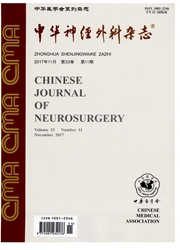

 中文摘要:
中文摘要:
目的从人脑胶质瘤组织中分离、培养胶质瘤干细胞,并探讨其生物学特性及其抗凋亡和多重耐药基因的表达差异。方法人脑胶质瘤组织经过原代细胞培养后,用无血清培养方法获得胶质瘤干细胞球,用10%的胎牛血清培养诱导分化,分化前后分别做nestin、tubulin—β、GFAP免疫细胞化学荧光染色,并观察胶质瘤干细胞形态学改变。同时,应用实时荧光定量PCR技术检测livin,livinm,livinβ,survivin,MRP1和MRP3 mRNA的表达。结果有2例分离培养出干细胞球体,这些球体具有典型的干细胞特性,nestin染色为阳性;在无血清培养基中呈悬浮球样生长,能够自我更新和增殖,在有血清培养基中能够分化,tubulin-β、GFAP染色为阳性。胶质瘤干细胞球livin、livinα、livinβ、survivin和MRP-1 mRNA表达量比较胶质瘤组织表达量都有不同程度的升高,而MRP-3 mRNA表达量降低。结论胶质瘤干细胞抗凋亡和MRP-1基因表达量较胶质瘤表达量有不同程度的升高,提示胶质瘤干细胞比较其同源的胶质瘤细胞具有更强的耐药性,这可能是肿瘤耐药的机制。
 英文摘要:
英文摘要:
Objective To isolate and culture glioma stem cells from primary glioma cells and detect the expression of anti- apoptotie and multidrug resistance -associated protein (MRP) genes. Methods Glioma stem cells were isolated from human glioma cell by physics technique and ncstin, β - tubulin and GFAP expression were examined by Immunofluoresenee staining. Expression of livin, livinα, livinβ, survivin, MRP1 and MRP3 were assayed by real - time quantitative RT - PCR. Results Glioma stem cells were induced successfully from two glioma specimens from one glioblastoma (No. 912110 ) and one grade 2 -3 astrocytoma subject (No. 916718). The glioma stem cells which were cultured in NSC medium grew in suspension and presented the features of stem cells: sphere - like shape, self - renewal and ability to differentiate. Nestin immunofluoresence staining of the stem cells presented positive, but the glioma did not show this feature. These cells could conditionally differentiate into tubulin - β^+ and GFAP ^+ cells, Which provided these cells in culture could produce neurons as well as glial cells. The mRNA expression of cancer stem cells on livin, living, survivin, MRP1 was significantly up - regulated than that of glioma primary cells. However, the mRNA expression of MRP3 was down - regulated. Conclusion Primary glioma cell contains cancer stem cells. The expression levels of anti - apoptotic and MRP1 genes are higher than that of glioma primary cells, which show glioma stem cells are the factor to maintain tumor growth and resist apoptosis and to pump the anti - tumor drugs out of cells, and this is what we need further research on.
 同期刊论文项目
同期刊论文项目
 同项目期刊论文
同项目期刊论文
 期刊信息
期刊信息
